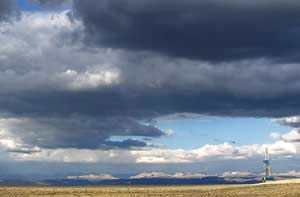ArcUser Online
Summer 2011 Edition
Is the Cloud Right for Your Organization?
Looking at hosted services in the oil and gas industries
This article as a PDF.

Most people use cloud services every day for e-mail, online banking, or driving directions. But are these online services appropriate for the oil and gas business? Keith Fraley, geo-information consultant for Shell Exploration and Production (E&P) in Houston, Texas, says it's time for the industry to get "SaaS-y." A longtime user of GIS software for E&P, Fraley talked with Barbara Shields, editor of the Esri newsletter Petroleum GIS Perspectives, about the benefits that Software as a Service (SaaS) data vendors could bring to the industry.
Shields: What data management problems do you see being resolved by hosted data services?
Fraley: Speaking primarily from a DaaS [Data as a Service] perspective, Internet technologies and infrastructure have advanced to a point that using a cloud service could potentially be more advantageous than managing data in-house. About 90 percent of a petroleum company's data is from external sources. E&P companies spend tremendous amounts of money and time internally managing datasets that they don't own but rather lease. Moving to an externally hosted solution for vendor datasets would significantly reduce the footprint of the IT systems in place internally and allow a company to focus on managing its own internally derived data.
An oil company's data can potentially come from hundreds of resources such as IHSE0, Tobin [oil and gas lease data], PennWell [Corporation], BLM [Bureau of Land Management], NOAA [National Oceanic and Atmospheric Administration], and many others. Internally managing so many datasets is a problem that forces you to be reactive. Because data providers' products have evolved over time, there is no uniform way of induction. Data is delivered by different means, from DVDs and FTP downloads to SDE imports and file geodatabases. It also arrives in periodic increments—some monthly, some quarterly, and some whenever the provider gets around to it. The GIS data manager is basically at the mercy of vendors' methods of delivering their data. It would be much easier if data managers could simply plug into a hosted service database whenever they need it. And if they don't need the data any longer, they could simply unplug rather than going through the task of expunging datasets and derived datasets (exported shapefiles, TIFFs, and x,y files) from their systems.
Shields: The Data as a Service model sounds good for the client, but why would a data vendor be interested in deploying cloud services?
Fraley: A data service provider is able to aggregate (build once, deploy everywhere) its operating environment and have new distribution channels. In addition, looking at access rates helps vendors see trends, predict growth, and meet demand. They would be able to simplify the pricing model that meets their clients' needs. Furthermore, rather than building monster-level patch rollouts and dataset pushes, the service provider could focus on smaller upgrades and real-time dataset updates.
Data and software web services are growing in popularity, and the change is inevitable. This trend cannot be ignored, and the data industry must act now to keep up with competition and the needs of its clients.
Shields: What basic ideology would data vendors need to address before making the transition from traditional data service to cloud services?

Keith Fraley, geoinforma-tion consultant for Shell Exploration and Production
Fraley: The ideology that oil and gas software products should be "walled gardens" must change. Oil and gas companies have a hard time being agile managing data because a lot of our vendors' products are designed to be walled gardens of proprietary software and data. They don't see that building products focused on interoperability and standards is in their best interest.
Shields: Petroleum companies have yet to adopt data and software hosted services. Why should they consider it?
Fraley: The model of DaaS from the cloud makes sense in the oil and gas world. In fact, I would argue that it is the perfect scenario for us. We are a very data-intensive industry. Most oil and gas companies house mammoth amounts of geospatial data, which has traditionally been locked up by power GIS users. As geospatial professionals, it is in our best interest to get that critical information to the people that make business-critical decisions. With a cloud model in place, our ability to build RIA [rich Internet applications] becomes easier. We can take our internally managed data and quickly mash it up with vendor web services and get it in front of the decision makers.
Shields: An often-heard argument by petroleum people is that cloud computing is a security risk and a bandwidth problem. Can you address these concerns?
Fraley: Security is absolutely a primary concern, and it should be. The Internet, by its very nature, is inherently insecure. This is the main reason why the concepts being discussed here are mainly SaaS as a one-way street. Oil and gas companies are consumers of data and do not push internally confidential data into the cloud. However, the security aspect will evolve and eventually get to the point where companies will not have great concern about storing critical, confidential information in the cloud, much like we as individuals do already in regard to the banking industry. Regarding bandwidth, many data services are delivered over standards and protocols such as XML and JSON [JavaScript Object Notation], which are not heavily bandwidth intensive. The beauty of this is that I can send spatial and nonspatial information through a simple REST URL, which is not a huge bandwidth hog.
Shields: What role do you see Esri playing in web mapping services?
Fraley: Esri has come a long way since the ArcIMS days, in terms of web services. It is building products that focus on interoperability and standards. ArcGIS Server is an excellent cloud-based product.
Some petroleum companies have stepped up to ArcGIS Server but are still using an ArcIMS approach, thinking that the new technology is merely a way to make pretty maps on the web. That is the tip of the iceberg of what the product can do for you. One example of ArcGIS Server as it relates to DaaS is the product's GeoData Service. This service gives the data vendor the ability to easily and quickly push data products (updates, deletes, and replication) to its client, eliminating the need for DVDs or FTP downloads.
Another example of Esri's commitment and understanding of the cloud is ArcGIS Online. My company is leveraging the free web mapping services of world imagery, topos, and street maps (and many more) available there. This saves us the cost and hassle of trying to manage that data in-house. From an SaaS perspective, the Esri cloud-hosted web APIs for JavaScript, Flex, and Silverlight provide a robust yet lightweight solution for developers.
Shields: How do you foresee the oil and gas industry moving into cloud services?
Fraley: The industry migration to the cloud will be an incremental process. There is no magic bullet for migrating decades of legacy systems and workflows to a new model, no matter how great the new model is. In the end, vendors and clients must understand the need for fundamental changes in the way data and software get delivered in our industry. Then they must have the technology, infrastructure, and knowledge in place to implement that change.